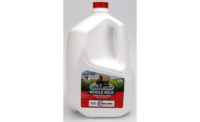High Desert Milk Inc.’s name pretty much spells out what the business is about and where it’s located. It was formed in Burley, Idaho, in 2001 by a progressive group of dairy men seeking to increase their return per hundredweight of milk and provide a stable market for their product.
By Barry Campbell
Burley milk facility benefits from burly piping alternative
High Desert Milk Inc.’s name pretty much spells out what the business is about and where it’s located. High Desert Milk was formed in Burley, Idaho in 2001 by a progressive group of dairy men seeking to increase their return per hundredweight of milk and provide a stable market for their product.
These co-operative owners milk 26,000 cows and farm 30,000 acres, and HDM’s 2007 sales exceeded $75 million. Due to continued growth, the company needed to build a processing plant in Burley to process more than 2 million lbs. of milk per day into 65 million lbs. of powdered milk per year.
HDM set out to build a new 100,000-square-feet facility with durability and functionality at its core. Obviously, the facility, which is 85-feet-high in spots, would have a tremendous amount of piping running through it.
Pipe first
Scott Palmer, president of A.H. Palmer & Sons, the plumbing and mechanical contractor on the project, explains that with over a mile of piping running through the facility, selecting the right piping options for the job was critical. Yet copper, which would have been the traditional option for many portions of the job, was selling at all time high rates when the job was being specified in spring 2007.
A.H. Palmer had used Aquatherm polypropylene-random piping for a cooling water loop at the Utah State University computer room in Logan, Utah, and Palmer suggested using the product on the HDM project. At first, the plant owners were a bit leery of using such a new-to-them piping product, but after some in-depth research they warmed to the idea.
Hansen followed up with USU officials about the product and also talked extensively with Aquatherm officials to learn as much as possible about the product. Aquatherm and A.H. Palmer gave HDM a thorough presentation and training session covering the in’s and out’s of polypropylene.
Aquatherm is so durable and leak- and corrosion-resistant that it's used extensively in acid waste and chemical process applications. It has been proven around the globe for 35 years, but is relatively new to North America.
“Other metals were considered, but after checking on some Aquatherm installations and considering the cost of metals at the time of construction, it was decided to use the Aquatherm product,” says Ralph Hansen, HDM’s maintenance manager for the Burley facility.
Aquatherm’s warranty also factored in the piping selection, according to Palmer. Aquatherm, which is manufactured in Germany, provides a 10-year warranty on pipe and fittings with a product liability valued at 9 million Euros for personal injury and 4.5 million Euros for property damage per event, to Aquatherm-trained and certified installers.
Installation speed and maintenance were the clinchers…
“The material labor costs, ease-of-maintenance and guarantee were all important, but the installation speed was the biggest thing,” Palmer says. “We can put this in quicker than we can put anything else in, and we don’t have to have a welder. One guy can do a three-inch Aquatherm installation when you would need three installers to put in a similar steel pipe. It was a ‘push job’ and we were doing everything we could to save an hour.”
Since the A.H. Palmer staff of roughly 20 installers working on this project was new to Aquatherm, the company held a three-hour training session covering the basics and more. While Palmer says his welders were also initially skeptical of the fusion welding process, they accepted it pretty quickly.
“It’s like any new product – a guy in the field or a guy in the office selling it is a big factor. The guys didn’t complain about it, and the plumbers loved it. They found it to be very simple, and if you follow the procedures it’s an easy product to work with,” Palmer says.
An additional benefit that helped convince HDM select Aquatherm was its ease of maintenance. Palmer explains that on a 4-inch compressed air line, a maintenance person can “drill a hole, slap his iron in there, and then he can put a branch line in instead of torching a hole in and welding into the three-inch line like you would with copper or steel. Additionally if you want to add a line and valve it off, you can do it a lot quicker and get the system back online,” he adds.
Palmer says that HDM was thrilled to be able to keep some maintenance in-house.
“They don’t have to have a welder. The plant is up and running a lot quicker. It cuts us out of maintenance but on something that simple, it is no big deal and it saves them a lot of money. They’d pay $100 instead of $300,” he says.
Hansen added that the fact that Aquatherm was approved by the state building inspector for use on non-potable water and compressed air made his acceptance of the product much easier.
Perfect for potable and…cow water
While Palmer recommended Aquatherm for many plant systems, the owners opted for stainless steel in some spots due to aesthetics – its metallic appearance. However, Aquatherm Greenpipe was used for compressed air, cow water and door-and-foot foamers, with more than 4,000 lineal feet installed throughout the plant.
Fully recyclable, Aquatherm Greenpipe is designed specifically for potable water applications. The majority of the PP-R on the project was Greenpipe, but Aquatherm Climatherm, which doesn’t have the potable water characteristics and is more suitable for HVAC, compressed air and industrial applications were also employed.
When milk is brought into the facility, it is processed through separators. Each gallon of milk is actually about 40% water, so instead of wasting that water (called “cow water”) and letting it go down the drain, it is captured and heated for use in washdown systems.
Traditionally, the cow water lines would have been copper or stainless steel, but Palmer says that in addition to cost benefits, Aquatherm was used because it is NSF-approved and doesn’t need insulation. The cow water, which is heated to 140-160°F by an AERCO water heater and used for spray downs and cleaning, can also be used in the plant’s Superior Boiler Works, Inc. 800-hp stream boilers.
The compressed air system runs at 120 psi and serves the door foamers and foot foamers. The air is used to increase the pressure on the sprayers, which are used like a steam cleaner for spraying down tanks and floors, cleaning, and in the facility’s maintenance shop.
Aquatherm was also used to supply water to the roughly 40 Armstrong International, Inc. hose reel stations which are used for hose downs and washing and three Goulds 7GB WaterGun High-Pressure Multi-Stage Booster Pumps.
Warming to fusion
The Aquatherm aspect of the HDM project consisted of about 4,000 lineal feet of Greenpipe and Climatherm, including thousands of fittings including sockets, tees, saddles, 90s, 45s, stainless steel adapters and socket-weld-to-stainless-steel-adapters. The heat fusion process used to join the pipe bonds both sides of a joint into a single, homogenous material, without the use of flames, chemicals or mechanical connections. Once fused, pipes and fittings have the same physical properties, thus eliminating systematic weaknesses that can be caused by introducing different materials into the joint in other types of piping systems. The material is also extremely corrosion resistant.
For the HDM job, A.H. Palmer used the heat fusion tools it already owned, but also rented some from Ferguson Enterprises’ Logan office. HDM also purchased the tools necessary to maintain all installed sizes of Aquatherm piping.
Out of 500 or so connections, A.H. Palmer had a total of four leaks. Two of the four resulted from a piece of cracked pipe, and the others were simple operator error.
“With copper I’d say we’d have had about the same number of leaks. But with the black threaded steel, there probably would have 20-25% more leaks, and with threaded stainless, it would have been roughly the same or maybe a bit higher,” Palmer says.
He adds that Aquatherm’s operator error failure rate is extremely low but with threaded metals, “there are so many factors, like thread tightness or making sure you have a proper thread on the pipe.” Palmer estimated the labor installation savings over copper at about 25%, explaining that a 3-inch copper joint is estimated to take 0.75 hour, and Aquatherm is about 0.50 hour. “Overall we saved about 25% on labor with Aquatherm compared to copper.” Against steel, the savings would have been more substantial. “With 3-inch steel it would have been 1.15 hour and again only half an hour to fuse an Aquatherm joint,” he says.
The lighter weight of PP-R also aided in labor savings since it’s easier to carry and handle.
“Aquatherm is a lot easier to handle than copper or steel – yes you have to hang it a bit more often, but one guy can handle it as opposed to two guys handling it and getting it into lifts and hanging it. One guy can do it all by himself, so there’s a lot of savings there,” he adds.
Wrapping up
The job, which was started in August 2007, was completed in September 2008. A.H. Palmer had roughly 60 employees working seven days a week in the last 4-5 months of the project and about 15 installers were exclusively working with Aquatherm.
With the facility up and running and everything going smoothly, Hansen says Aquatherm’s PP-R piping has, “lived up to its claims.” He expects to use the product in future jobs, and A.H. Palmer has done several more jobs using Aquatherm.
Sidebar
Almost 4,000 lineal feet of Aquatherm Greenpipe and Climatherm is installed throughout the HDM plant, ranging from ½-inch to 4-inch. Here’s a breakdown of the types/sizes installed:
1,000 ft – 4-inch
500 ft – 3-inch
1,000 ft – 2-inch
500 ft – 1 ½-inch
500 – 1 ¼-inch
2,000 ft – ¾-inch
2,000 ft – ½-inch
Thousands of fittings including sockets, tees, saddles, 90s, 45s, stainless steel adapters and socket-weld-to-stainless-steel-adapters.
Contact info:
Ralph Hansen, plant manager
rhansen@highdesertmilk.com
208-312-3454 cell
Scott Palmer, president
A.H. Palmer & Sons
435-752-4814 (W)
435-994-2054 (C)
Get our new eMagazine delivered to your inbox every month.
Stay in the know on the latest dairy industry trends.
SUBSCRIBE TODAYCopyright ©2024. All Rights Reserved BNP Media.
Design, CMS, Hosting & Web Development :: ePublishing


